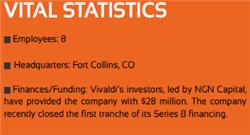Companies To Watch: Vivaldi Biosciences
By Wayne Koberstein, Executive Editor, Life Science Leader
Follow Me On Twitter @WayneKoberstein
This early-research company seeks to fill current gaps in protection with a novel target and live-cell approach for development of superior seasonal as well as universal and pandemic flu vaccines.
SNAPSHOT
Vivaldi Biosciences is aiming to parlay its new vaccine target and live-cell approach to accomplish an unprecedented level of protection against the flu, using live attenuated influenza vaccines (LAIVs) to stimulate multiple arms of the immune system: antibodies, T-cells, and interferon. Its candidate LAIVs for seasonal and pandemic influenza have completed four randomized, double-blind, placebo-controlled clinical trials in a total of 245 volunteers. Vivaldi’s LAIVs are based on manipulation of the influenza nonstructural protein (NS1) gene, with the goal of providing superior efficacy. NS1 is a virulence factor of the influenza virus.
LATEST UPDATES
- October 2013: Acquired clinical-stage influenza vaccine assets from Baxter Healthcare SA.
- October 2013: Series B financing, first closing.
- Current: Entering a cooperative research and development agreement (CRADA) with the National Institute of Allergy and Infectious Diseases (NIAID) for pandemic influenza.
 WHAT’S AT STAKE
WHAT’S AT STAKE
When a CEO states an overwhelming record of failure in the area his company is working, you know the stakes are high. Speaking at the BIO Investor Forum in October, Dr. Douglass Given of Vivaldi cited 89 companies that had tried and failed to develop a universal flu vaccine, 55 of them in Phase 1 trials. Why should his company, alone, succeed? In so many words, it came down to two points: 1) Vivaldi’s vaccines stimulate the immune system in new, multiple ways, and 2) unlike all the other candidates in the class, the company’s vaccines are live.
“Live vaccines are considered the ‘gold standard’ for many other vaccine-preventable diseases — for example, polio and yellow fever — providing potent, long-lasting immunity with a low dose,” says Given, in a post-BIF exchange. “Live vaccines also have excellent safety and efficacy records. The potential of a live vaccine for influenza has not been reached.” He says FluMist, the only approved LAIV, is too attenuated to elicit a protective immune response in the elderly or for pandemic-flu protection.
Vivaldi’s vaccines are also unique in targeting the NS1 gene, which affects virulence and is present in both A and B flu strains. “LAIVs with deleted or truncated NS1 generate a robust immune response — they stimulate the body’s production of interferon, which acts as a natural adjuvant, activating the cellular immune response and enhancing production of antibodies, including neutralizing antibodies cross-reactive with variant (drifted) influenza strains,” says Given. To the company’s knowledge, it is a novel mode of action among all licensed influenza vaccines and vaccines in development.
“There is a tremendous need and very little innovation in the area of vaccines that provide superior efficacy in the prevention of seasonal influenza,” Given maintains. “Most ‘universal’ vaccine approaches are years away from clinical evaluation.”
Although the company wants a commercial pharma partner in the long run, it knows it must make a strong case for its approach with human data. “Many influenza vaccine development approaches fail because positive preclinical data do not translate to promising clinical results,” Given says. “Vivaldi has strong preclinical and clinical data with its NS1 technology approach.” Vivaldi already has data from a Phase 1 study of its LAIV against highly pathogenic avian influenza A(H5N1), or “bird flu,” demonstrating proof-of-concept and tolerability.
 Given says Vivaldi’s approach will allow a rapid response to emerging strains through reverse genetics and plasmid rescue technologies, “reducing the time from strain isolation to start of vaccine manufacture.” Vero cell-based manufacturing “addresses strategic needs in the event of an HPAI (highly pathogenic avian influenza) pandemic,” producing LAIVs that are dose-sparing without the need for an adjuvant, and in nasal-spray form for mass use and selfadministration in a pandemic setting. The company just strengthened its IP and technology options with the purchase of additional rights to NS1-based technologies, along with data from four related Phase 1 trials, from Baxter. If you want to watch any company forging ahead with the next generation of flu vaccines, you probably won’t find one with a better case than Vivaldi.
Given says Vivaldi’s approach will allow a rapid response to emerging strains through reverse genetics and plasmid rescue technologies, “reducing the time from strain isolation to start of vaccine manufacture.” Vero cell-based manufacturing “addresses strategic needs in the event of an HPAI (highly pathogenic avian influenza) pandemic,” producing LAIVs that are dose-sparing without the need for an adjuvant, and in nasal-spray form for mass use and selfadministration in a pandemic setting. The company just strengthened its IP and technology options with the purchase of additional rights to NS1-based technologies, along with data from four related Phase 1 trials, from Baxter. If you want to watch any company forging ahead with the next generation of flu vaccines, you probably won’t find one with a better case than Vivaldi.
